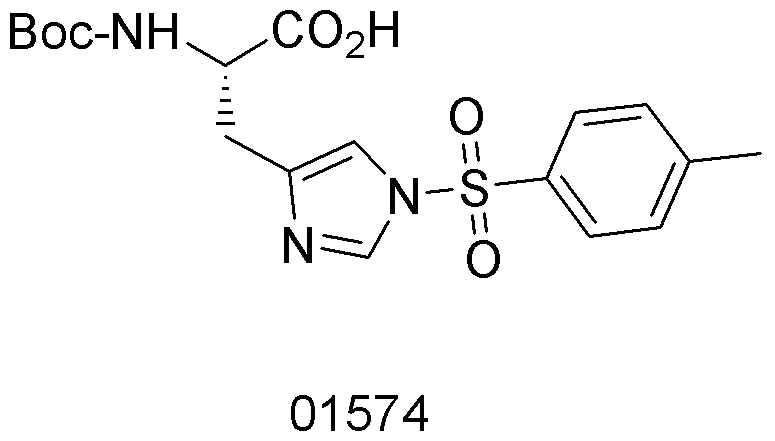Na-Boc-Nim-4-toluenesylfonyl-L-histidine is widely utilized in research focused on:
- Peptide Synthesis: This compound serves as a protecting group in the synthesis of peptides, allowing for selective reactions without interfering with other functional groups. This is crucial in developing complex biomolecules.
- Drug Development: Its unique structure makes it valuable in designing novel pharmaceuticals, particularly in creating inhibitors for specific biological targets, enhancing drug efficacy.
- Bioconjugation: It is used in bioconjugation processes to attach biomolecules to surfaces or other molecules, which is essential in creating targeted drug delivery systems and diagnostic tools.
- Research in Cancer Therapeutics: The compound is being explored for its potential in cancer treatment, particularly in creating targeted therapies that minimize side effects compared to traditional chemotherapy.
- Protein Engineering: It aids in the modification of proteins to improve their stability and activity, which is vital in biotechnology and therapeutic applications.
General Information
Properties
Safety and Regulations
Applications
Na-Boc-Nim-4-toluenesylfonyl-L-histidine is widely utilized in research focused on:
- Peptide Synthesis: This compound serves as a protecting group in the synthesis of peptides, allowing for selective reactions without interfering with other functional groups. This is crucial in developing complex biomolecules.
- Drug Development: Its unique structure makes it valuable in designing novel pharmaceuticals, particularly in creating inhibitors for specific biological targets, enhancing drug efficacy.
- Bioconjugation: It is used in bioconjugation processes to attach biomolecules to surfaces or other molecules, which is essential in creating targeted drug delivery systems and diagnostic tools.
- Research in Cancer Therapeutics: The compound is being explored for its potential in cancer treatment, particularly in creating targeted therapies that minimize side effects compared to traditional chemotherapy.
- Protein Engineering: It aids in the modification of proteins to improve their stability and activity, which is vital in biotechnology and therapeutic applications.
Documents
Safety Data Sheets (SDS)
The SDS provides comprehensive safety information on handling, storage, and disposal of the product.
Product Specification (PS)
The PS provides a comprehensive breakdown of the product’s properties, including chemical composition, physical state, purity, and storage requirements. It also details acceptable quality ranges and the product's intended applications.
Certificates of Analysis (COA)
Search for Certificates of Analysis (COA) by entering the products Lot Number. Lot and Batch Numbers can be found on a product’s label following the words ‘Lot’ or ‘Batch’.
Número de catálogo
Número de lote/lote
Certificates Of Origin (COO)
This COO confirms the country where the product was manufactured, and also details the materials and components used in it and whether it is derived from natural, synthetic, or other specific sources. This certificate may be required for customs, trade, and regulatory compliance.
Número de catálogo
Número de lote/lote
Safety Data Sheets (SDS)
The SDS provides comprehensive safety information on handling, storage, and disposal of the product.
DownloadProduct Specification (PS)
The PS provides a comprehensive breakdown of the product’s properties, including chemical composition, physical state, purity, and storage requirements. It also details acceptable quality ranges and the product's intended applications.
DownloadCertificates of Analysis (COA)
Search for Certificates of Analysis (COA) by entering the products Lot Number. Lot and Batch Numbers can be found on a product’s label following the words ‘Lot’ or ‘Batch’.
Número de catálogo
Número de lote/lote
Certificates Of Origin (COO)
This COO confirms the country where the product was manufactured, and also details the materials and components used in it and whether it is derived from natural, synthetic, or other specific sources. This certificate may be required for customs, trade, and regulatory compliance.


